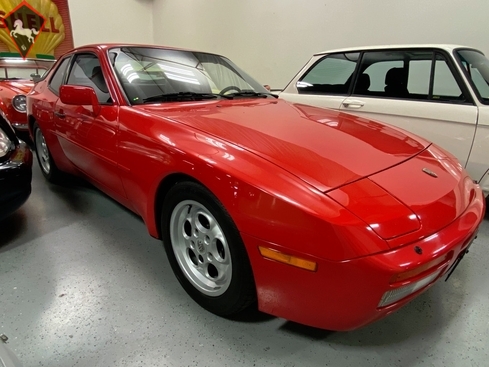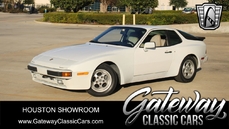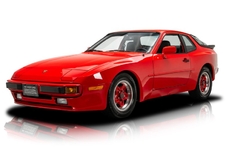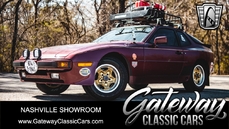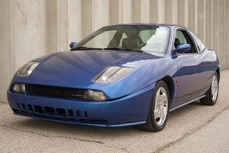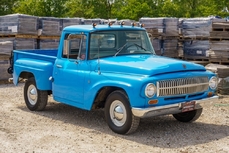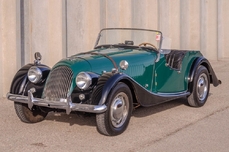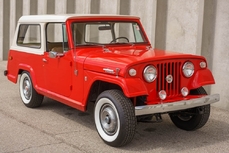Porsche 944 2.5L I4 8V Turbo Hatchback 1986
Allgemeine Beschreibung :
1986 Porsche 944 Turbo
One of 7,513 944 Turbos exported to the U.S., in 1986
Turbocharged 2.5L DOHC four-cylinder engine (code M44/51) with counter-rotating balance shafts
Five-speed manual transaxle
Guards Red exterior (code L027) and black leather/vinyl interior (code 1DR)
Air-conditioning converted to R134A, power windows and sunroof with detachable panel
Five-cup alloy wheels, VDO gauges, foglights
One of most recognizable Porsche models, the 944, began as something quite different. By the mid-1980s, Porsche created a new and formidable front-engine car and owned by the same fastidious owner since 2015!
Made in Neckarsulm near Stuttgart, West Germany, this example is one of only10,937 Porsche 944 Turbos made in 1986 and one of 7,513 944 Turbos exported to the US. Dressed in Guards Red (code L027), the car’s paint and trim are in overall very good order, the bodywork is straight and solid and the engine bay is extremely tidy. In front, the bumper is integrated into the rest of the car’s design while the red-and-black rear bumper looks great.
This 944 rolls on Fuzion ZR1 radials, size 205/55R16 in front and 245/45R16 in back. Each tire is mounted on a Porsche alloy wheel, known either as the five-cup style or the phone dial type. The wheels and tires are all in very good order.
Under the hood is Porsche’s massive turbocharged 2.5L DOHC four-cylinder engine (code M44/51). The new all-alloy engine was in essence, half of the 928’s 5.0 L V8 engine. Not typical in luxury sports cars, the four-cylinder engine was chosen for fuel efficiency and size and because it had to be fitted from below on the Neckarsulm production line. To overcome roughness caused by the unbalanced secondary forces that are typical of inline four-cylinder engines, Porsche included two counter-rotating balance shafts, patented by Mitsubishi, running at twice the engine speed.
Backing this motor is a five-speed manual transmission that is part of the car’s rear-mounted transaxle. The car had a nearly even front to rear weight distribution (50.7 percent front/49.3 percent rear) courtesy of the rear transaxle balancing out the engine in the front. Driver convenience features include power windows
Inside, the car’s immaculate black leather and vinyl interior (code 1DR) is in overall very good order. The front bucket seats and rear demi-buckets are in overall excellent shape. The matching black carpet is in very good order, as is the black headliner. A traditional four-spoke steering wheel frames the instrument panel, which features a full array of VDO gauges. The horn works, but intermittently. The simple, yet functional black dashboard looks great, as do the inner door panels. The center console and shift remain in excellent order. A Sony AM/FM stereo with CD player completes the interior.
In mid-1985, the 944 underwent its first significant changes, these included: new dashboard and door panels, embedded radio antenna, upgraded alternator (from 90 amp to 115 amp), increased oil sump capacity, new front and rear cast alloy control arms and semi-trailing arms, larger fuel tank, optional heated and powered seats, Porsche HiFi sound system and revisions in the mounting of the transaxle to reduce noise and vibration. The front windshield was now a flush-mounted unit. The "cookie cutter" style wheels used in the early 944s were upgraded to new "phone dial" style wheels (Fuchs wheels remained an option).
For the 1986 model year, Porsche introduced the 944 Turbo, known internally as the 951. The Turbo had a turbocharged and intercooled version of the standard 944’s engine. The Turbo was the first Porsche production car using a ceramic port liner to retain exhaust gas temperature along with new forged pistons and was also the first vehicle to produce an identical power output with or without a catalytic converter. The Turbo also featured several other changes, such as improved aerodynamics, notably an integrated front bumper. This featured the widest turn signals (indicators) fitted to any production car, a strengthened gearbox with a different final drive ratio, standard external oil coolers for both the engine and transmission, standard 16-inch wheels (optional forged Fuchs wheels), and a slightly stiffer suspension (progressive springs) to handle the extra weight. The Turbo's front and rear brakes were borrowed from the 911, with Brembo four-piston fixed calipers and 12-inch discs. Engine component revisions, more than 30 in all, were made to the 951 to compensate for increased internal loads and heat.
Competition to this Porsche in 1986 included Audi’s Quattro, Chevrolet’s Corvette, Ferrari’s Mondial 3.2, Lotus Ésprit, Nissan’s 300ZX and Renault’s Alpine GTA.
Porsche fans, German car lovers and anyone looking for a solid classic driver, should stop by MotoeXotica Classic Cars to take a peek at this 944 Turbo.
VIN: WP0AA0955GN151722
This car is currently located at our facility in St. Louis, Missouri. Current mileage on the odometer shows 94,666 miles. It is sold as is, where is, on a clean and clear, mileage exempt Wisconsin title. GET OUT AND DRIVE!!!
https://www.motoexotica.com/inventory/inventory/15277/1986/Porsche/944/WP0AA0955GN151722.html
1986 Porsche 944 2.5L I4 8V Turbo Hatchback is listed verkauft on ClassicDigest in Fenton (St. Louis) by for $33900.
Fakten der Auto
Karosserietyp : Auto Marke : Porsche Modell : 944 Ausführung : 2.5L I4 8V Turbo Hatchback Hubraum : 0.0 Modelljahr : 1986 Karosstyp : Sedan Lage : Fenton (St. Louis)
Verkauft
Angaben Zum Verkäufer
Verkauft
People who viewed this Porsche 944 also viewed similar Porsche listed at ClassicDigest
Other cars listed for sale by this dealer
über Porsche
Die Geschichte von Porsche ist eine faszinierende Reise von ihren bescheidenen Anfängen zu einem legendären Sportwagenhersteller. Hier ist ein umfangreicher Überblick über die ersten Jahre bis in die neunziger Jahre, einschließlich Models und deren Renngeschichte:Frühe Anfänge:
Gründung und frühe Modelle: Das Unternehmen wurde 1931 von Ferdinand Porsche gegründet und konzentrierte sich zunächst auf Automobilberatung und -design.
Volkswagen Käfer- und Pre-War-Prototypen: Insbesondere Ferdinand Porsche entwarf den Volkswagen Beetle, und in den 1930er Jahren entwickelte das Unternehmen mehrere innovative Rennwagen und Prototypen, wie die Autos der Automineration Grand Prix.
Nachkriegsentwicklung:
Porsche 356 (1948-1965): Das erste Produktionsmodell von Porsche, einem leichten und flinkenden Sportwagen, entwickelte sich durch verschiedene Iterationen, darunter Speedster- und Carrera-Versionen.
Rennerfolg: Der 356 gründete das Rennerbe von Porsche, gewann zahlreiche Rennen und etablierte sich als leistungsorientierte Marke.
Ikonische Modelle der 1960er bis 1990er Jahre:
Porsche 911 (1964):
Dauerhaftes Vermächtnis: Der legendäre 911 mit seiner Layout im Hintermotor hat eine kontinuierliche Entwicklung und bleibt der typische Porsche-Sportwagen.
Varianten und Evolution: Von den frühen luftgekühlten Modellen bis hin zu den moderneren wassergekühlten Versionen hat der 911 erhebliche technische Fortschritte und Modellvariationen erfahren.
Porsche 914 (1969-1976):
Zusammenarbeit mit Volkswagen: Der gemeinsame mit Volkswagen entwickelte Mid-Engine 914 bot einen günstigeren Einstieg in den Besitz von Porsche.
Porsche 924/944/968 Serie (1976-1995):
Vordermodelle: Diese Vordermodelle zielten darauf ab, ein breiteres Publikum anzulocken und ein anderes Fahrerlebnis im Vergleich zum Heckmotor 911 zu bieten.
Rennerbe:
Le Mans und Langurance Racing: Porsche's Racing Heritage umfasst zahlreiche Siege bei prestigeträchtigen Veranstaltungen wie Le Mans, die die Exzellenz und Performance der Marke präsentieren.
Can-Am, Rallying und Touring Cars: Der Erfolg von Porsche in verschiedenen Renndisziplinen trugen erheblich zu seinem Ruf und technischen Fortschritten in der Automobiltechnik bei.
Technologische Fortschritte:
Turbo-Ladung und Innovationen: Porsche löste Pionier in Produktionsautos mit dem 911 Turbo, die modernste Technologie einführten, die die Automobilindustrie beeinflusste.
Advanced Engineering: Im Laufe der Jahre verfeinerte Porsche seine Engineering kontinuierlich und führte Innovationen in der Aerodynamik, Handhabung und Materialien ein.
Abschluss:
Porsches Reise von den frühen Beratungsjahren bis zum Synonym für Hochleistungssportwagen ist geprägt von Innovationen, Rennerfolg und dem legendären 911. Das unerbittliche Streben nach Exzellenz und Rennsport-Triumphien hat den Status von Porsche als einen der verehrten und ikonischen Sportarten festgelegt Autohersteller weltweit.
